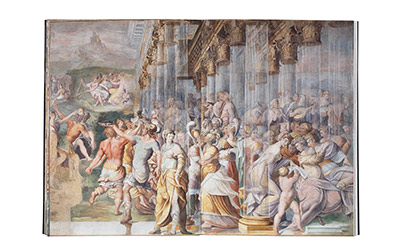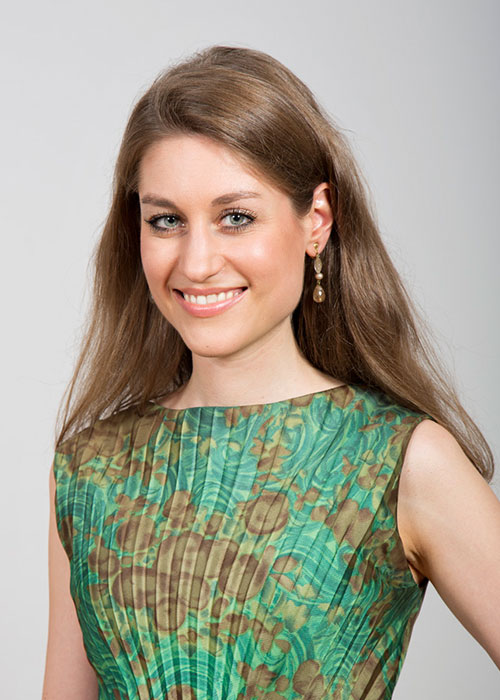Jacopo Zanguidi, called il Bertoja,

(Parma 1544–1573)
Mars, Venus and Cupid, pen and brown ink, on laid paper, on an old support fixed to another laid paper, old inscriptions with attributions to Parmigianino and Salviati on the reverse, 15 x 11,5 cm, mounted, unframed, (Sch)
Provenance:
Collection Baron Adolphe Augustin Rey de Villette (Mailand 1864–1934 Breteuil), Lugt 2200a; anonymous collector’s mark monogram HB (not with Lugt);
private collection, Italy.
With a copy of a certificate by Dr. Maria Cristina Chiusa, 27th August 2020.
The present sheet with Mars, Venus und Cupid is a preparatory study for the detail “the Kiss“ in the famous fresco depicting a dancing scene in the Sala dell’Aetas Felicior also known as Sala del Bacio in the Palazzo del Giardino in Parma. The decoration of the palace was commissioned by Ottavio Farnese. Jacopo Zanguidi can easily be identified as contributing artist as he collaborated with Girolamo Mirola from the 1560s in the residence of the Farnese. Mirola had been already active in the service of the Farnese and had become the leading master of the painting cycles in the palace of Parma. At the beginning of the collaboration between Mirola and Il Bertoja the latter’s graphic activity had gained a significant role in his work. Bertoja was such a gifted draftsman that he may have inspired Mirola. As was shown in the catalogue of the recent exhibition La Maniera Emiliana: Bertoja, Mirola, da Parma alle corti d’Europa, in Parma 2019, Bertoja’s intervention was not limited to the completion of the ceiling frescoes. Bertoja also participated in the execution of the majority of the wall decorations in the palace. (see: M. C. Chiusa, „Mirola e Bertoja per il „casino grande“ di Ottavio Farnese a Parma“, in: Cat. Parma 2019, pp. 23-35).
The frescoes by Girolamo Mirola (Bologna, 1535/1540 - Parma, 1570) and Jacopo Zanguidi, called Il Bertoja (Parma, 1544-1573), which Ottavio Farnese had chosen for the entire decoration in the „casino grande“ in Parma were part of an iconographic program, which was typical in the 16th century. Mirola and Bertoja executed frescoes in the Aetas felicior-Saal as well as in the adjacent room, which is known as sala d’ariosto and whose painting decoration is also dedicated to stories of love. The two artists also painted five mythological frescoes in a third room of the building. Other than that, they decorated today’s attic of the palace with mythological motifs. According to the wish of their patron the artists transformed the famous verses of Vergil „Trahetas sua quemque voluptas“ (Vergil, „...trahit sua quemque voluptas“, Ec. II, 65) into painting in the so-called sala del Bacio, suggesting the room to be a place where the power of love seemed to prevail in a Vergilian manner.
The present drawing is determined by characteristic features of Bertoja’s pen stroke, which can be often found in the artist’s work. The five mythological frescoes of the garden palace (oil on plaster transformed to canvas), which are preserved in the Gallery of Parma today, must be seen together with the motif of the „Kiss“ which is mentioned above. Especially the picture Venus and Mars (oil on plaster, transformed to canvas, 37,1 x 62 cm, Palazzo del Giardino, Parma, Inv. 0898) deserves closer attention. Details such as in the helmet and in the shoes of the figures as well as the dynamic rhythm of the scene are characteristic for Bertoja’s work. Resemblances of his style can be also found in the present drawing’s figure of Mars. The figures and their elongated slender anatomy point to Bertoja’s early years in Parma around 1566.
In the present study Mars, Venus and Cupid the mythological love theme with the two gods embracing each other in the company of Cupid is rendered with vigorous pen strokes. The arrangement of the figures, the dramatic composition and the stylistical execution point to similarities with several figure studies in pen and brown ink by Bertoja, which are preserved in the Cabinet des Dessins of the Louvre (see: M. G. Donà, in: Cat. Parma 2019, pp. 165-168). Especially the drawing with a figure group, moving to the left in the Louvre (Inv. 6524), which was published by D. De Grazia, is comparable with the present drawing in regards to its quick and broken stroke and its dynamic and free movements. (see: D. De Grazia Bohlin, „Some Unpublished Drawings by Bertoja“, in: Master Drawings, XII, 4, 1974, pp. 359-367, 410-422). This and other examples show that the artist preferred incisive and sometimes agitated lines, which provide the hatchings with form and strenghten the vigour of the scene. Even the facial features, their morphology, such as the eyes, the nose and oval rounded faces are comparable with the drawings in the Louvre. Another comparable study, Diana and Mars, is kept in the National Gallery of Art, Washington (Inv. 1977; see De Grazia 1991, Fig. 108). In this drawing Parmigianio’s model image in the depiction of the figures becomes evident considering the figures’ elongated limbs.
We are grateful to Dr. Maria Cristina Chiusa for confirming the attribution and for the scientific support.

© Franco Maria Ricci Editore
Specialist: Mag. Astrid-Christina Schierz
 Mag. Astrid-Christina Schierz
Mag. Astrid-Christina Schierz
+43-1-515 60-546
astrid.schierz@dorotheum.at
20.10.2020 - 15:31
- Realized price: **
-
EUR 11,520.-
- Starting bid:
-
EUR 2,000.-
Jacopo Zanguidi, called il Bertoja,
(Parma 1544–1573)
Mars, Venus and Cupid, pen and brown ink, on laid paper, on an old support fixed to another laid paper, old inscriptions with attributions to Parmigianino and Salviati on the reverse, 15 x 11,5 cm, mounted, unframed, (Sch)
Provenance:
Collection Baron Adolphe Augustin Rey de Villette (Mailand 1864–1934 Breteuil), Lugt 2200a; anonymous collector’s mark monogram HB (not with Lugt);
private collection, Italy.
With a copy of a certificate by Dr. Maria Cristina Chiusa, 27th August 2020.
The present sheet with Mars, Venus und Cupid is a preparatory study for the detail “the Kiss“ in the famous fresco depicting a dancing scene in the Sala dell’Aetas Felicior also known as Sala del Bacio in the Palazzo del Giardino in Parma. The decoration of the palace was commissioned by Ottavio Farnese. Jacopo Zanguidi can easily be identified as contributing artist as he collaborated with Girolamo Mirola from the 1560s in the residence of the Farnese. Mirola had been already active in the service of the Farnese and had become the leading master of the painting cycles in the palace of Parma. At the beginning of the collaboration between Mirola and Il Bertoja the latter’s graphic activity had gained a significant role in his work. Bertoja was such a gifted draftsman that he may have inspired Mirola. As was shown in the catalogue of the recent exhibition La Maniera Emiliana: Bertoja, Mirola, da Parma alle corti d’Europa, in Parma 2019, Bertoja’s intervention was not limited to the completion of the ceiling frescoes. Bertoja also participated in the execution of the majority of the wall decorations in the palace. (see: M. C. Chiusa, „Mirola e Bertoja per il „casino grande“ di Ottavio Farnese a Parma“, in: Cat. Parma 2019, pp. 23-35).
The frescoes by Girolamo Mirola (Bologna, 1535/1540 - Parma, 1570) and Jacopo Zanguidi, called Il Bertoja (Parma, 1544-1573), which Ottavio Farnese had chosen for the entire decoration in the „casino grande“ in Parma were part of an iconographic program, which was typical in the 16th century. Mirola and Bertoja executed frescoes in the Aetas felicior-Saal as well as in the adjacent room, which is known as sala d’ariosto and whose painting decoration is also dedicated to stories of love. The two artists also painted five mythological frescoes in a third room of the building. Other than that, they decorated today’s attic of the palace with mythological motifs. According to the wish of their patron the artists transformed the famous verses of Vergil „Trahetas sua quemque voluptas“ (Vergil, „...trahit sua quemque voluptas“, Ec. II, 65) into painting in the so-called sala del Bacio, suggesting the room to be a place where the power of love seemed to prevail in a Vergilian manner.
The present drawing is determined by characteristic features of Bertoja’s pen stroke, which can be often found in the artist’s work. The five mythological frescoes of the garden palace (oil on plaster transformed to canvas), which are preserved in the Gallery of Parma today, must be seen together with the motif of the „Kiss“ which is mentioned above. Especially the picture Venus and Mars (oil on plaster, transformed to canvas, 37,1 x 62 cm, Palazzo del Giardino, Parma, Inv. 0898) deserves closer attention. Details such as in the helmet and in the shoes of the figures as well as the dynamic rhythm of the scene are characteristic for Bertoja’s work. Resemblances of his style can be also found in the present drawing’s figure of Mars. The figures and their elongated slender anatomy point to Bertoja’s early years in Parma around 1566.
In the present study Mars, Venus and Cupid the mythological love theme with the two gods embracing each other in the company of Cupid is rendered with vigorous pen strokes. The arrangement of the figures, the dramatic composition and the stylistical execution point to similarities with several figure studies in pen and brown ink by Bertoja, which are preserved in the Cabinet des Dessins of the Louvre (see: M. G. Donà, in: Cat. Parma 2019, pp. 165-168). Especially the drawing with a figure group, moving to the left in the Louvre (Inv. 6524), which was published by D. De Grazia, is comparable with the present drawing in regards to its quick and broken stroke and its dynamic and free movements. (see: D. De Grazia Bohlin, „Some Unpublished Drawings by Bertoja“, in: Master Drawings, XII, 4, 1974, pp. 359-367, 410-422). This and other examples show that the artist preferred incisive and sometimes agitated lines, which provide the hatchings with form and strenghten the vigour of the scene. Even the facial features, their morphology, such as the eyes, the nose and oval rounded faces are comparable with the drawings in the Louvre. Another comparable study, Diana and Mars, is kept in the National Gallery of Art, Washington (Inv. 1977; see De Grazia 1991, Fig. 108). In this drawing Parmigianio’s model image in the depiction of the figures becomes evident considering the figures’ elongated limbs.
We are grateful to Dr. Maria Cristina Chiusa for confirming the attribution and for the scientific support.

© Franco Maria Ricci Editore
Specialist: Mag. Astrid-Christina Schierz
 Mag. Astrid-Christina Schierz
Mag. Astrid-Christina Schierz
+43-1-515 60-546
astrid.schierz@dorotheum.at
|
Buyers hotline
Mon.-Fri.: 10.00am - 5.00pm
kundendienst@dorotheum.at +43 1 515 60 200 |
| Auction: | Master Drawings, Prints before 1900, Watercolours, Miniatures |
| Auction type: | Online auction |
| Date: | 20.10.2020 - 15:31 |
| Location: | Vienna | Palais Dorotheum |
| Exhibition: | 14.10.2020 - 20.10.2020 |
** Purchase price incl. charges and taxes
It is not possible to turn in online buying orders anymore. The auction is in preparation or has been executed already.
